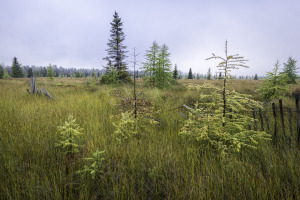 In July, 2016, American Peat Technology requested a lease arrangement with the State of Minnesota and Aitkin County for two peatlands with the intention of harvesting peat. One of the deposits is located just east of the current manufacturing site, and the second deposit is located southeast of Malmo, Minnesota. Both of the sites have good quality, reed-sedge peat, of a sufficient depth to make harvest economical.
In July, 2016, American Peat Technology requested a lease arrangement with the State of Minnesota and Aitkin County for two peatlands with the intention of harvesting peat. One of the deposits is located just east of the current manufacturing site, and the second deposit is located southeast of Malmo, Minnesota. Both of the sites have good quality, reed-sedge peat, of a sufficient depth to make harvest economical.
Just requesting the lease, however, is the easy part. Because the deposits encompass both state and county land, a joint powers agreement has to be negotiated between both parties. Historically, the state has been the acting party and will, in all likelihood, be the governmental unit to either grant or deny the lease request. If the lease is granted, the lease language will cover everything from the annual per acre cost of leasing the land to the royalty payments on the peat removed. The lease will also address the need for environmental review, a reclamation bond and a plan for peat harvest.
If the lease is granted, then APT can begin the process of requesting an environmental review of the project. The size of the leases will necessitate an environmental impact statement (EIS) rather than the less-intensive environmental assessment worksheet (EAW). An EIS is a notoriously laborious process, and there is nothing about the review that is hasty. The EIS documents the impact that the project will have, in part, on the hydrology, land surface, fish, wildlife and flora, air quality and transportation infrastructure. Companies and organizations that undertake an EIS generally plan on the process taking from 18 months to three years.
Concurrent with the environmental review, APT can start to negotiate environmental permits made necessary by the project. The most common permits for peat harvest are the Section 404 permit, issued by the US Army Corps of Engineers, the Minnesota Department of Natural Resources’ permit to mine and water appropriation permit, and the Minnesota Pollution Control Agency’s National Pollutant Discharge Elimination Permit. Additionally, the county may have some requirements regarding dust, air quality, noise and utilities.
If, at the end of the day, the project passes environmental review and the permits are granted, then and only then can APT start the process of peat harvest on the new deposits. However, the start of harvest has its own set of hurdles, including water management, access roads and processing sites. Although the lease requests were made in July 2016, it could easily be four or five years before the first pound of peat is harvested for commercial use.
Why go through all this trouble? What is so valuable about peat, that it justifies this kind of effort? American Peat Technology has built a solid business foundation by drying and processing peat for the agronomy and water remediation markets. Our biological carriers transport beneficial microorganisms and micronutrients to the agriculture field, and our water remediation products harness the natural affinity that peat has for toxic heavy metals, and transform it into an easy-to-use granule. Our products contribute to green solutions for ag and water, but they require the peat resource to be a reality. We’d like that resource, and the accompanying jobs and economic benefit, to be located squarely within Aitkin County. Stay tuned to hear of our progress.
